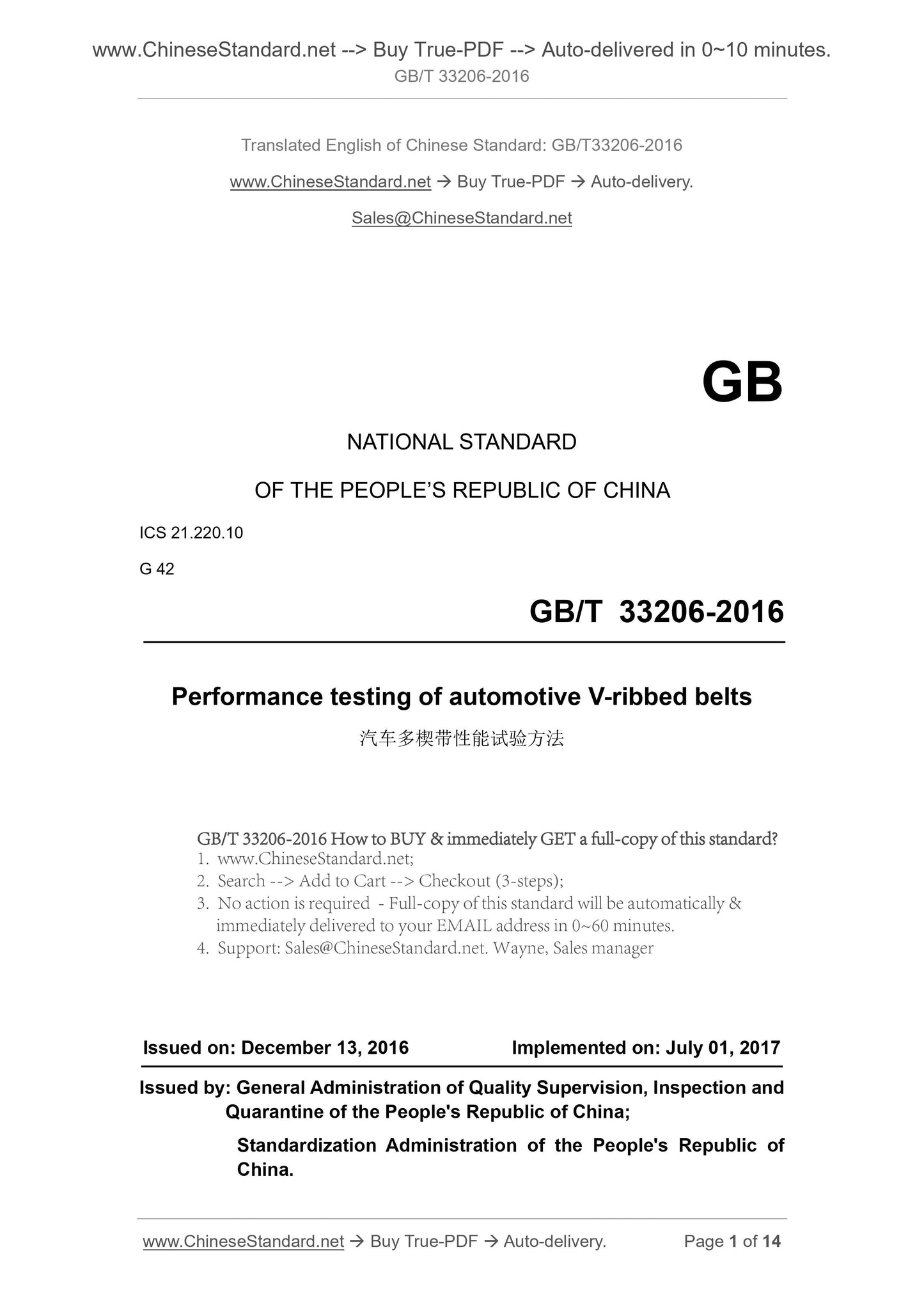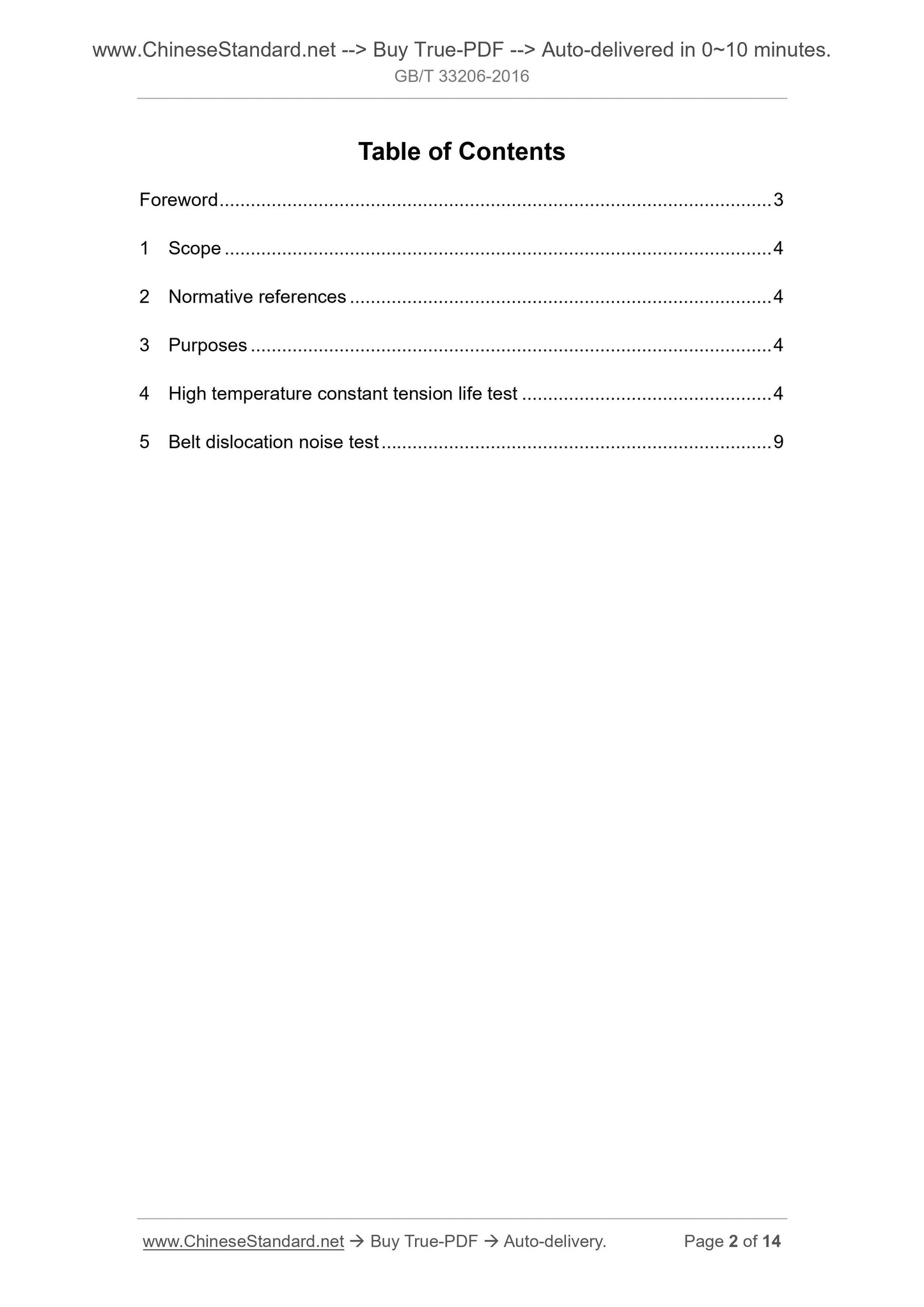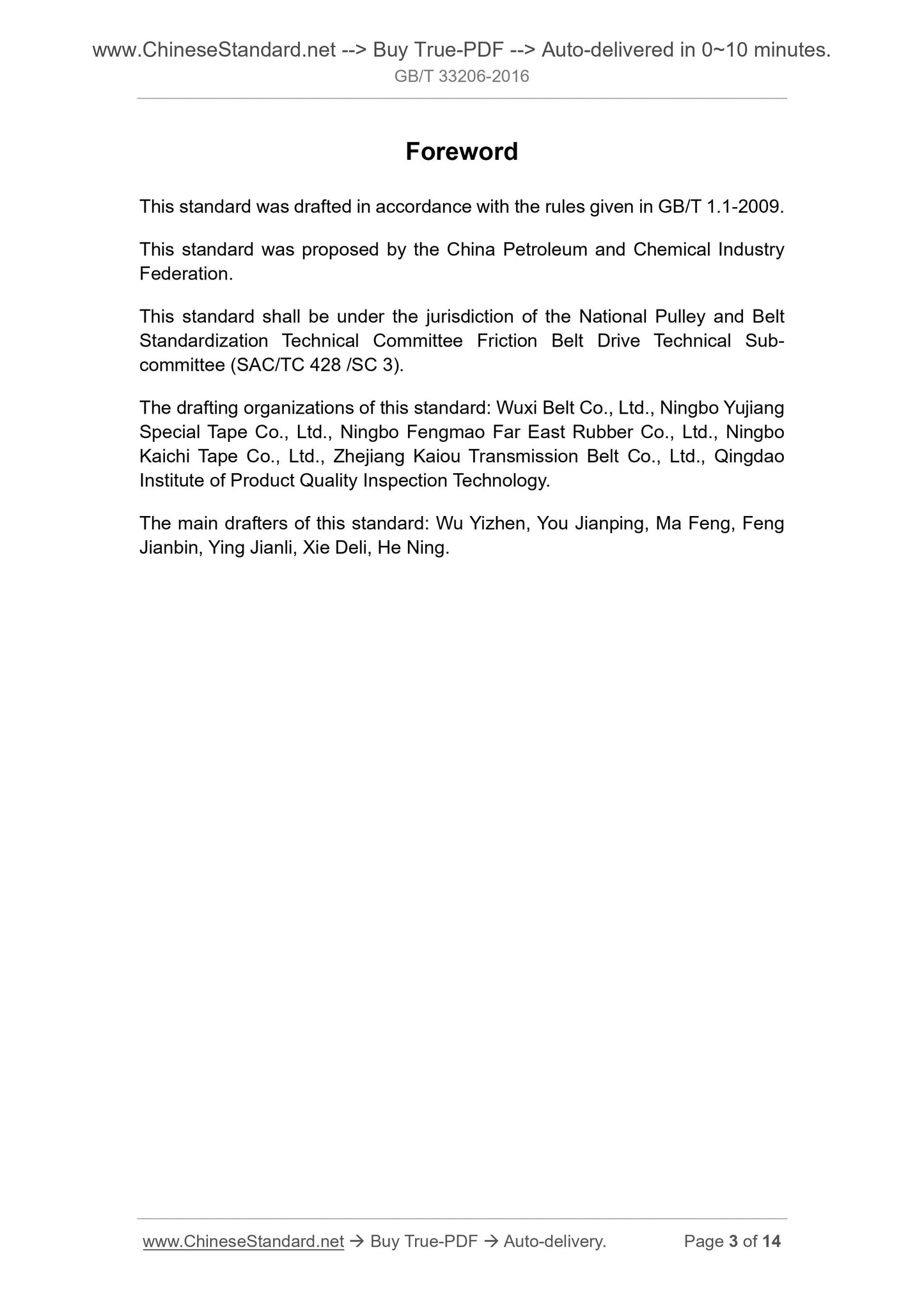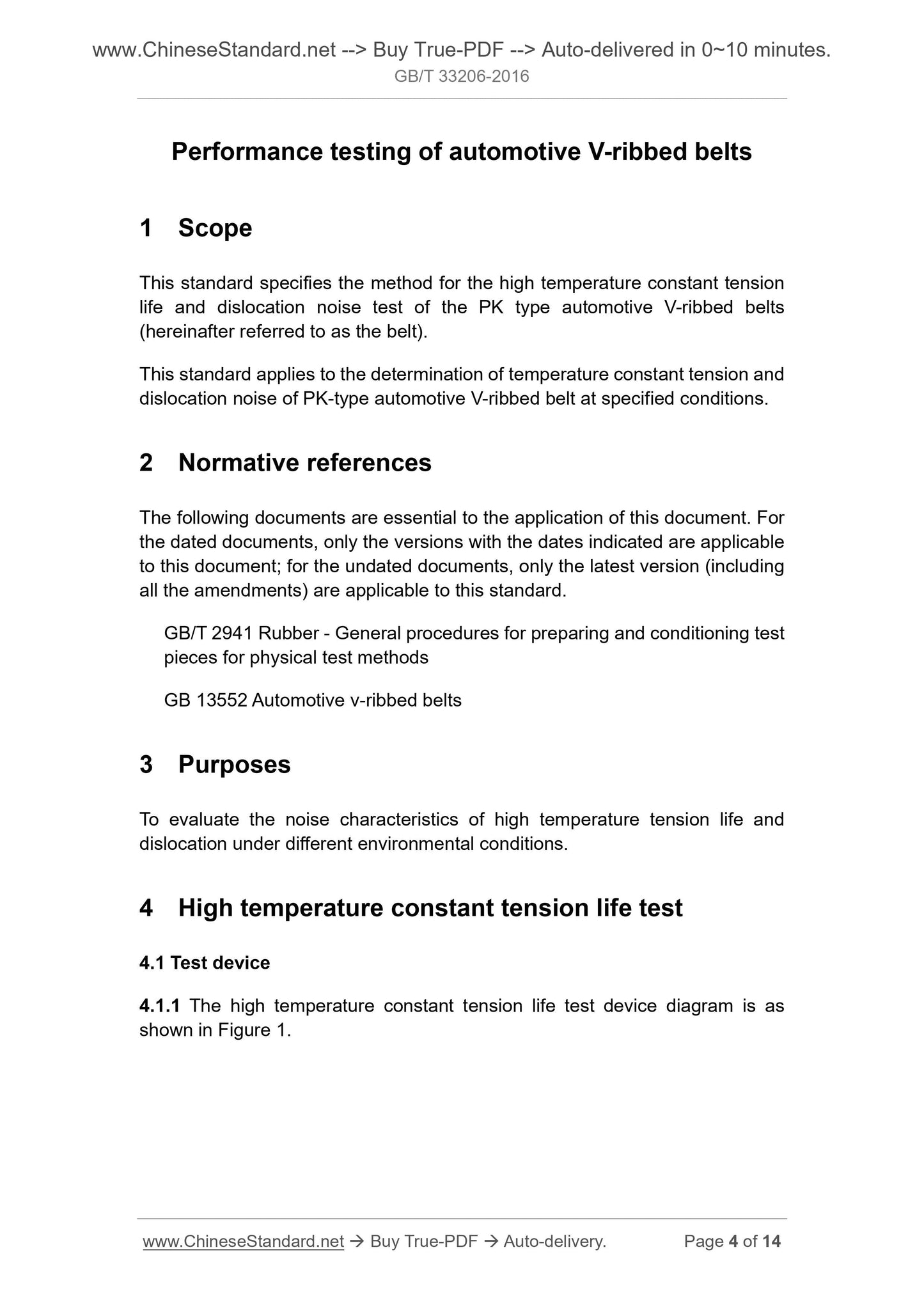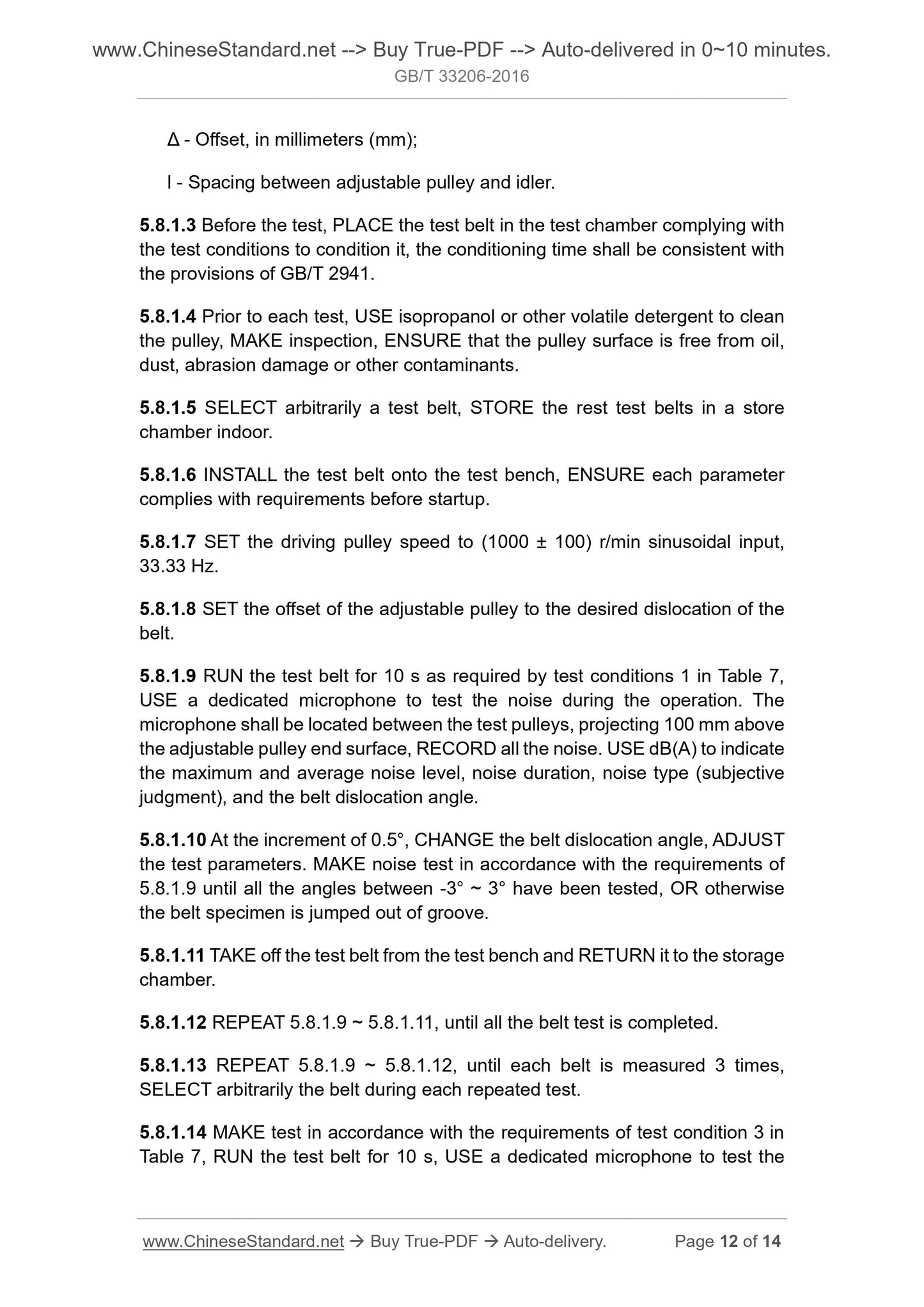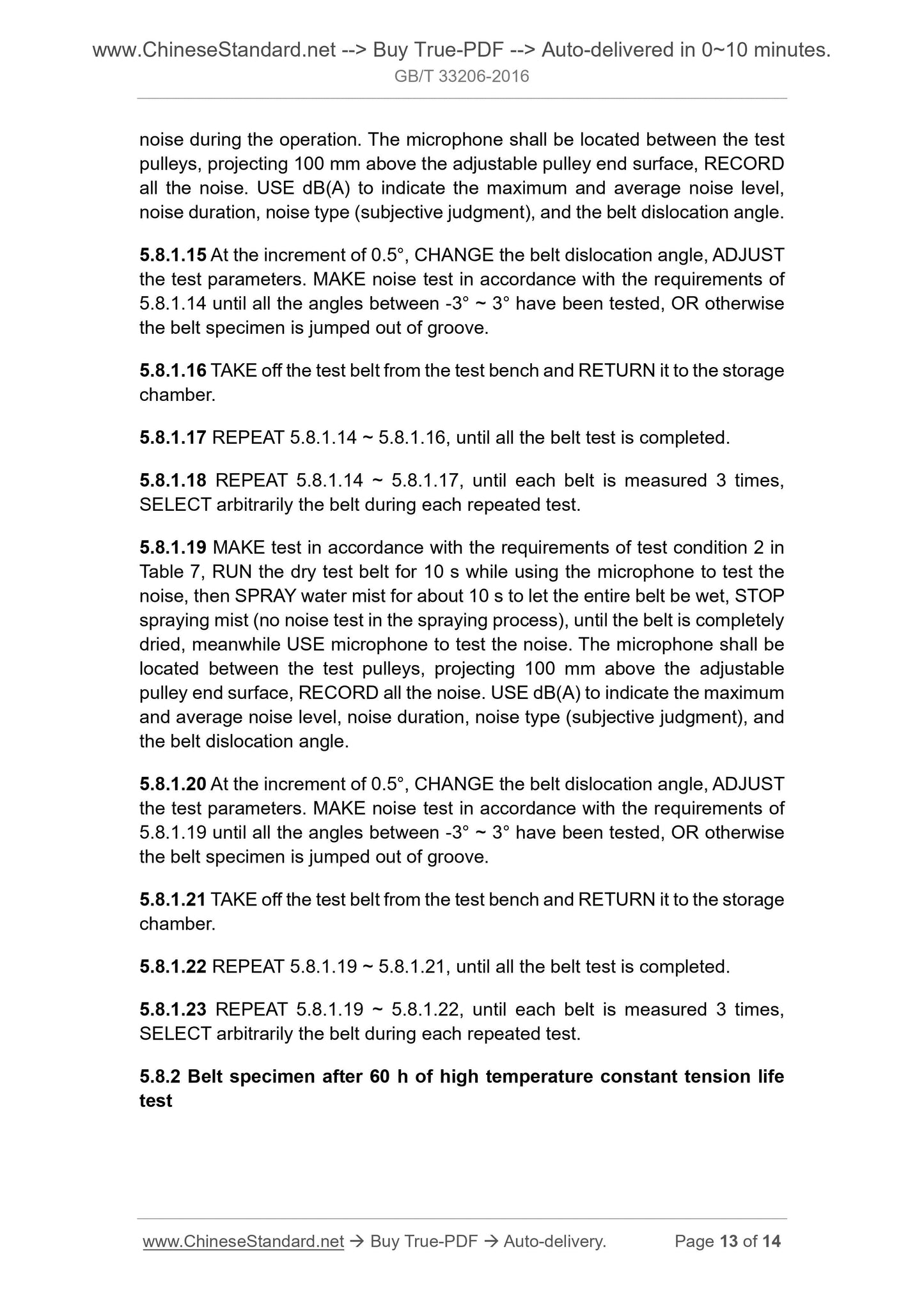1
/
of
6
PayPal, credit cards. Download editable-PDF & invoice in 1 second!
GB/T 33206-2016 English PDF (GB/T33206-2016)
GB/T 33206-2016 English PDF (GB/T33206-2016)
Regular price
$120.00 USD
Regular price
Sale price
$120.00 USD
Unit price
/
per
Shipping calculated at checkout.
Couldn't load pickup availability
Delivery: 3 seconds. Download true-PDF + Invoice.
Get QUOTATION in 1-minute: Click GB/T 33206-2016
Historical versions: GB/T 33206-2016
Preview True-PDF (Reload/Scroll if blank)
GB/T 33206-2016: Performance testing of automotive V-ribbed belts
GB/T 33206-2016
GB
NATIONAL STANDARD
OF THE PEOPLE’S REPUBLIC OF CHINA
ICS 21.220.10
G 42
Performance testing of automotive V-ribbed belts
ISSUED ON. DECEMBER 13, 2016
IMPLEMENTED ON. JULY 01, 2017
Issued by. General Administration of Quality Supervision, Inspection and
Quarantine of the People's Republic of China;
Standardization Administration of the People's Republic of
China.
Table of Contents
Foreword ... 3
1 Scope ... 4
2 Normative references ... 4
3 Purposes ... 4
4 High temperature constant tension life test ... 4
5 Belt dislocation noise test ... 9
Foreword
This standard was drafted in accordance with the rules given in GB/T 1.1-2009.
This standard was proposed by the China Petroleum and Chemical Industry
Federation.
This standard shall be under the jurisdiction of the National Pulley and Belt
Standardization Technical Committee Friction Belt Drive Technical Sub-
committee (SAC/TC 428 /SC 3).
The drafting organizations of this standard. Wuxi Belt Co., Ltd., Ningbo Yujiang
Special Tape Co., Ltd., Ningbo Fengmao Far East Rubber Co., Ltd., Ningbo
Kaichi Tape Co., Ltd., Zhejiang Kaiou Transmission Belt Co., Ltd., Qingdao
Institute of Product Quality Inspection Technology.
The main drafters of this standard. Wu Yizhen, You Jianping, Ma Feng, Feng
Jianbin, Ying Jianli, Xie Deli, He Ning.
Performance testing of automotive V-ribbed belts
1 Scope
This standard specifies the method for the high temperature constant tension
life and dislocation noise test of the PK type automotive V-ribbed belts
(hereinafter referred to as the belt).
This standard applies to the determination of temperature constant tension and
dislocation noise of PK-type automotive V-ribbed belt at specified conditions.
2 Normative references
The following documents are essential to the application of this document. For
the dated documents, only the versions with the dates indicated are applicable
to this document; for the undated documents, only the latest version (including
all the amendments) are applicable to this standard.
GB/T 2941 Rubber - General procedures for preparing and conditioning test
pieces for physical test methods
GB 13552 Automotive v-ribbed belts
3 Purposes
To evaluate the noise characteristics of high temperature tension life and
dislocation under different environmental conditions.
4 High temperature constant tension life test
4.1 Test device
4.1.1 The high temperature constant tension life test device diagram is as
shown in Figure 1.
Δ - Offset, in millimeters (mm);
l - Spacing between adjustable pulley and idler.
5.8.1.3 Before the test, PLACE the test belt in the test chamber complying with
the test conditions to condition it, the conditioning time shall be consistent with
the provisions of GB/T 2941.
5.8.1.4 Prior to each test, USE isopropanol or other volatile detergent to clean
the pulley, MAKE inspection, ENSURE that the pulley surface is free from oil,
dust, abrasion damage or other contaminants.
5.8.1.5 SELECT arbitrarily a test belt, STORE the rest test belts in a store
chamber indoor.
5.8.1.6 INSTALL the test belt onto the test bench, ENSURE each parameter
complies with requirements before startup.
5.8.1.7 SET the driving pulley speed to (1000 ± 100) r/min sinusoidal input,
33.33 Hz.
5.8.1.8 SET the offset of the adjustable pulley to the desired dislocation of the
belt.
5.8.1.9 RUN the test belt for 10 s as required by test conditions 1 in Table 7,
USE a dedicated microphone to test the noise during the operation. The
microphone shall be located between the test pulleys, projecting 100 mm above
the adjustable pulley end surface, RECORD all the noise. USE dB(A) to indicate
the maximum and average noise level, noise duration, noise type (subjective
judgment), and the belt dislocation angle.
5.8.1.10 At the increment of 0.5°, CHANGE the belt dislocation angle, ADJUST
the test parameters. MAKE noise test in accordance with the requirements of
5.8.1.9 until all the angles between -3° ~ 3° have been tested, OR otherwise
the belt specimen is jumped out of groove.
5.8.1.11 TAKE off the test belt from the test bench and RETURN it to the storage
chamber.
5.8.1.12 REPEAT 5.8.1.9 ~ 5.8.1.11, until all the belt test is completed.
5.8.1.13 REPEAT 5.8.1.9 ~ 5.8.1.12, until each belt is measured 3 times,
SELECT arbitrarily the belt during each repeated test.
5.8.1.14 MAKE test in accordance with the requirements of test condition 3 in
Table 7, RUN the test belt for 10 s, USE a dedicated microphone to test the
noise during the operation. The microphone shall be located between the test
pulleys, projecting 100 mm above the adjustable pulley end surface, RECORD
all the noise. USE dB(A) to indicate the maximum and average noise level,
noise duration, noise type (subjective judgment), and the belt dislocation angle.
5.8.1.15 At the increment of 0.5°, CHANGE the belt dislocation angle, ADJUST
the test parameters. MAKE noise test in accordance with the requirements of
5.8.1.14 until all the angles between -3° ~ 3° have been tested, OR otherwise
the belt specimen is jumped out of groove.
5.8.1.16 TAKE off the test belt from the test bench and RETURN it to the storage
chamber.
5.8.1.17 REPEAT 5.8.1.14 ~ 5.8.1.16, until all the belt test is completed.
5.8.1.18 REPEAT 5.8.1.14 ~ 5.8.1.17, until each belt is measured 3 times,
SELECT arbitrarily the belt during each repeated test.
5.8.1.19 MAKE test in accordance with the requirements of test condition 2 in
Table 7, RUN the dry test belt for 10 s while using the microphone to test the
noise, then SPRAY water mist for about 10 s to let the entire belt be wet, STOP
spraying mist (no noise test in the spraying process), until the belt is completely
dried, meanwhile USE microphone to test the noise. The microphone shall be
located between the test pulleys, projecting 100 mm above the adjustable
pulley end surface, RECORD all the noise. USE dB(A) to indicate the maximum
and average noise level, noise duration, noise type (subjective judgment), and
the belt dislocation angle.
5.8.1.20 At the increment of 0.5°, CHANGE the belt dislocation angle, ADJUST
the test parameters. MAKE noise test in accordance with the requirements of
5.8.1.19 until all the angles between -3° ~ 3° have been tested, OR otherwise
the belt specimen is jumped out of groove.
5.8.1.21 TAKE off the test belt from the test bench and RETURN it to the storage
chamber.
5.8.1.22 REPEAT 5.8.1.19 ~ 5.8.1.21, until all the belt test is completed.
5.8.1.23 REPEAT 5.8.1.19 ~ 5.8.1.22, until each belt is measured 3 times,
SELECT arbitrarily the belt during each repeated test.
5.8.2 Belt specimen after 60 h of high temperature constant tension life
test
Get QUOTATION in 1-minute: Click GB/T 33206-2016
Historical versions: GB/T 33206-2016
Preview True-PDF (Reload/Scroll if blank)
GB/T 33206-2016: Performance testing of automotive V-ribbed belts
GB/T 33206-2016
GB
NATIONAL STANDARD
OF THE PEOPLE’S REPUBLIC OF CHINA
ICS 21.220.10
G 42
Performance testing of automotive V-ribbed belts
ISSUED ON. DECEMBER 13, 2016
IMPLEMENTED ON. JULY 01, 2017
Issued by. General Administration of Quality Supervision, Inspection and
Quarantine of the People's Republic of China;
Standardization Administration of the People's Republic of
China.
Table of Contents
Foreword ... 3
1 Scope ... 4
2 Normative references ... 4
3 Purposes ... 4
4 High temperature constant tension life test ... 4
5 Belt dislocation noise test ... 9
Foreword
This standard was drafted in accordance with the rules given in GB/T 1.1-2009.
This standard was proposed by the China Petroleum and Chemical Industry
Federation.
This standard shall be under the jurisdiction of the National Pulley and Belt
Standardization Technical Committee Friction Belt Drive Technical Sub-
committee (SAC/TC 428 /SC 3).
The drafting organizations of this standard. Wuxi Belt Co., Ltd., Ningbo Yujiang
Special Tape Co., Ltd., Ningbo Fengmao Far East Rubber Co., Ltd., Ningbo
Kaichi Tape Co., Ltd., Zhejiang Kaiou Transmission Belt Co., Ltd., Qingdao
Institute of Product Quality Inspection Technology.
The main drafters of this standard. Wu Yizhen, You Jianping, Ma Feng, Feng
Jianbin, Ying Jianli, Xie Deli, He Ning.
Performance testing of automotive V-ribbed belts
1 Scope
This standard specifies the method for the high temperature constant tension
life and dislocation noise test of the PK type automotive V-ribbed belts
(hereinafter referred to as the belt).
This standard applies to the determination of temperature constant tension and
dislocation noise of PK-type automotive V-ribbed belt at specified conditions.
2 Normative references
The following documents are essential to the application of this document. For
the dated documents, only the versions with the dates indicated are applicable
to this document; for the undated documents, only the latest version (including
all the amendments) are applicable to this standard.
GB/T 2941 Rubber - General procedures for preparing and conditioning test
pieces for physical test methods
GB 13552 Automotive v-ribbed belts
3 Purposes
To evaluate the noise characteristics of high temperature tension life and
dislocation under different environmental conditions.
4 High temperature constant tension life test
4.1 Test device
4.1.1 The high temperature constant tension life test device diagram is as
shown in Figure 1.
Δ - Offset, in millimeters (mm);
l - Spacing between adjustable pulley and idler.
5.8.1.3 Before the test, PLACE the test belt in the test chamber complying with
the test conditions to condition it, the conditioning time shall be consistent with
the provisions of GB/T 2941.
5.8.1.4 Prior to each test, USE isopropanol or other volatile detergent to clean
the pulley, MAKE inspection, ENSURE that the pulley surface is free from oil,
dust, abrasion damage or other contaminants.
5.8.1.5 SELECT arbitrarily a test belt, STORE the rest test belts in a store
chamber indoor.
5.8.1.6 INSTALL the test belt onto the test bench, ENSURE each parameter
complies with requirements before startup.
5.8.1.7 SET the driving pulley speed to (1000 ± 100) r/min sinusoidal input,
33.33 Hz.
5.8.1.8 SET the offset of the adjustable pulley to the desired dislocation of the
belt.
5.8.1.9 RUN the test belt for 10 s as required by test conditions 1 in Table 7,
USE a dedicated microphone to test the noise during the operation. The
microphone shall be located between the test pulleys, projecting 100 mm above
the adjustable pulley end surface, RECORD all the noise. USE dB(A) to indicate
the maximum and average noise level, noise duration, noise type (subjective
judgment), and the belt dislocation angle.
5.8.1.10 At the increment of 0.5°, CHANGE the belt dislocation angle, ADJUST
the test parameters. MAKE noise test in accordance with the requirements of
5.8.1.9 until all the angles between -3° ~ 3° have been tested, OR otherwise
the belt specimen is jumped out of groove.
5.8.1.11 TAKE off the test belt from the test bench and RETURN it to the storage
chamber.
5.8.1.12 REPEAT 5.8.1.9 ~ 5.8.1.11, until all the belt test is completed.
5.8.1.13 REPEAT 5.8.1.9 ~ 5.8.1.12, until each belt is measured 3 times,
SELECT arbitrarily the belt during each repeated test.
5.8.1.14 MAKE test in accordance with the requirements of test condition 3 in
Table 7, RUN the test belt for 10 s, USE a dedicated microphone to test the
noise during the operation. The microphone shall be located between the test
pulleys, projecting 100 mm above the adjustable pulley end surface, RECORD
all the noise. USE dB(A) to indicate the maximum and average noise level,
noise duration, noise type (subjective judgment), and the belt dislocation angle.
5.8.1.15 At the increment of 0.5°, CHANGE the belt dislocation angle, ADJUST
the test parameters. MAKE noise test in accordance with the requirements of
5.8.1.14 until all the angles between -3° ~ 3° have been tested, OR otherwise
the belt specimen is jumped out of groove.
5.8.1.16 TAKE off the test belt from the test bench and RETURN it to the storage
chamber.
5.8.1.17 REPEAT 5.8.1.14 ~ 5.8.1.16, until all the belt test is completed.
5.8.1.18 REPEAT 5.8.1.14 ~ 5.8.1.17, until each belt is measured 3 times,
SELECT arbitrarily the belt during each repeated test.
5.8.1.19 MAKE test in accordance with the requirements of test condition 2 in
Table 7, RUN the dry test belt for 10 s while using the microphone to test the
noise, then SPRAY water mist for about 10 s to let the entire belt be wet, STOP
spraying mist (no noise test in the spraying process), until the belt is completely
dried, meanwhile USE microphone to test the noise. The microphone shall be
located between the test pulleys, projecting 100 mm above the adjustable
pulley end surface, RECORD all the noise. USE dB(A) to indicate the maximum
and average noise level, noise duration, noise type (subjective judgment), and
the belt dislocation angle.
5.8.1.20 At the increment of 0.5°, CHANGE the belt dislocation angle, ADJUST
the test parameters. MAKE noise test in accordance with the requirements of
5.8.1.19 until all the angles between -3° ~ 3° have been tested, OR otherwise
the belt specimen is jumped out of groove.
5.8.1.21 TAKE off the test belt from the test bench and RETURN it to the storage
chamber.
5.8.1.22 REPEAT 5.8.1.19 ~ 5.8.1.21, until all the belt test is completed.
5.8.1.23 REPEAT 5.8.1.19 ~ 5.8.1.22, until each belt is measured 3 times,
SELECT arbitrarily the belt during each repeated test.
5.8.2 Belt specimen after 60 h of high temperature constant tension life
test
Share
